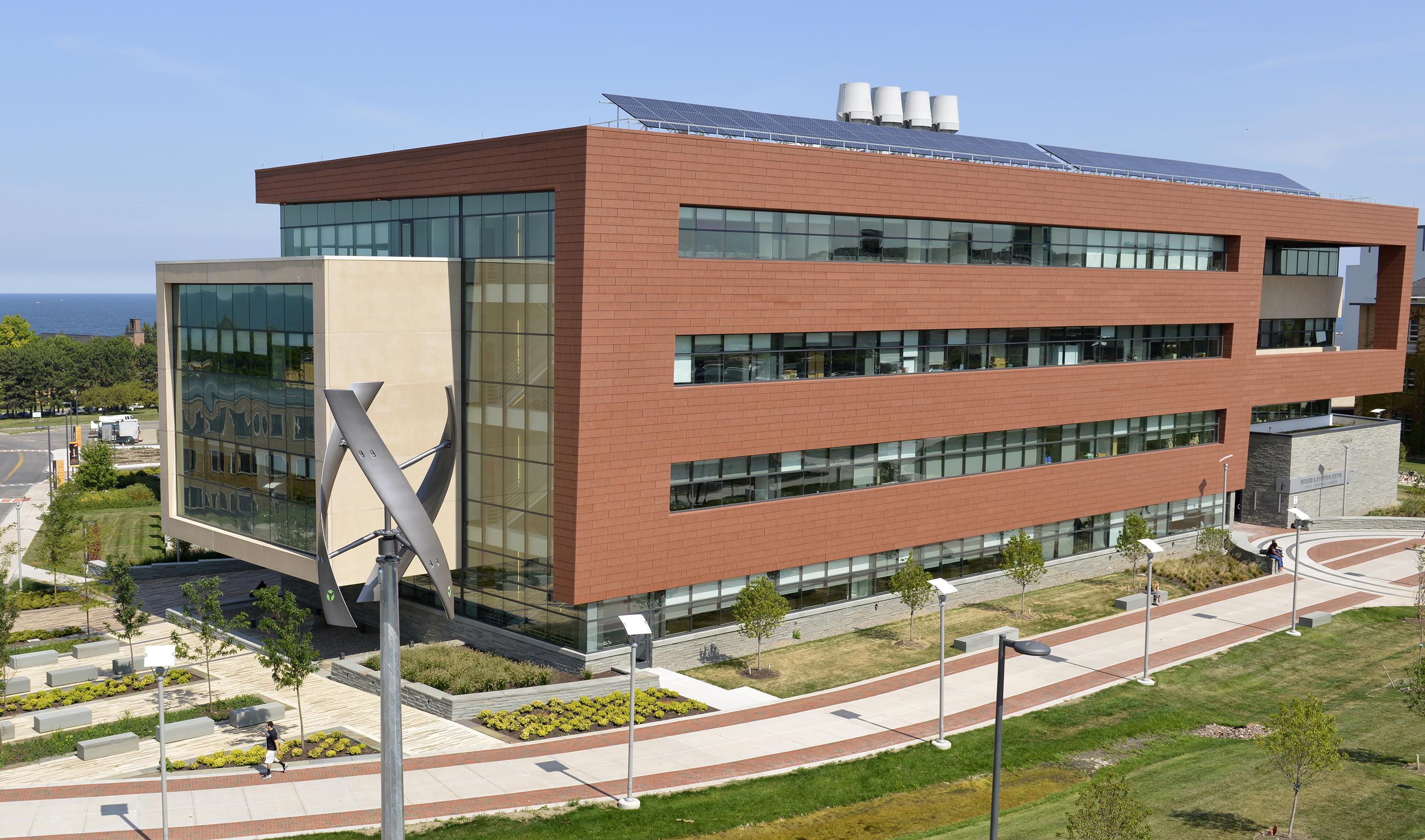Gold standard—SUNY Oswego’s Richard S. Shineman Center for Science, Engineering and Innovation, shown with the demonstration wind turbine in foreground and solar panel array on the roof, has achieved Leadership in Energy and Environmental Design (LEED) Gold certification from the U.S. Green Building Council.
Tried and proven over two Oswego winters, SUNY Oswego’s Richard S. Shineman Center for Science, Engineering and Innovation, which opened in fall 2013, has received the Leadership in Energy and Environmental Design (LEED) Gold rating from the U.S. Green Building Council.
The 230,000-square-foot environmentally friendly science complex replaced 45-year-old Snygg Hall. As a consequence, the college saved on utility costs last year, even though the winter was one of the coldest on record, said Nicholas Lyons, vice president for administration and finance.
LEED is a green building certification program that recognizes best-in-class building strategies and practices, according to the U.S. Green Building Council. LEED-certified buildings save money and resources and have a positive impact on the health of occupants, while promoting renewable, clean energy.
“This is huge,” Mitch Fields, Oswego’s associate vice president for facilities services, said of the LEED Gold achievement, noting that science buildings—with all of their laboratories—pose special challenges to air, water and energy systems.
Among Shineman’s green features are the state’s largest geothermal-well installation, recycled fly ash in the estimated 13,000 cubic yards of concrete, state-of-the art foam insulation and curtain-wall construction that help seal the building, innovative windows and shades that optimize daylight and energy savings, a vertical wind turbine and rooftop solar panels that tie in to the building’s electrical system, water bottle filling stations, chemical fume hoods with energy-efficiency controls and monitoring, a solvent recycler to reduce the amount of acetone used in experiments, small roof gardens and four storm-water retention basins, as well as systems for monitoring water, light, heat and air conditioning.
The solar panels were temporarily removed after a storm damaged some of them Sept. 9. Fields said they will be reinstalled.
The building’s ground-level bike storage room, storage lockers and showers are used by the campus community’s bike riders. Other features also encourage fewer motor vehicle trips to campus: The many lounge areas throughout the Shineman Center encourage students to stay in the building to study rather than drive elsewhere. Wi-Fi is available throughout the building along with many wired ports. The Fusion Cafe offers a diverse menu and a variety of seating options.
“Sustainability is really ingrained in the building,” said Michael Lotito, engineering coordinator for the sustainability office.
Added this fall in the building’s main parking lot were the college’s first electric vehicle charging stations.
Step toward carbon neutrality
The Shineman Center has set a landmark on the college’s charted course to carbon neutrality by 2050. The Presidents’ Climate Commitment, signed by SUNY Oswego President Deborah F. Stanley in 2007, pledges to reduce the college’s carbon footprint 40 percent by then.
All new construction on campus since 2007 has been designed to at least LEED Silver standards. The Shineman Center is the second campus facility to achieve LEED Gold certification. The Village, a 68-unit townhouse complex for students residing on campus, won the gold rating in 2011.
Both are part of the college’s $800 million campus renewal, which—in addition to the primary goal of improving the learning and social environment for students—aims to meet rigorous standards of environmentally responsible construction.
“Our Shineman Center for Science, Engineering and Innovation stands out in so many ways,” said President Deborah F. Stanley. “The largest project in our campus renewal program, it is a model of environmental sustainability, a model for building teaching opportunities right into the facilities where students learn, and a model of an interdisciplinary science community that is mindful of the welfare of future generations as it pursues discovery and innovation.”
Named for the founding chair of the college’s chemistry department, the building was a focal point for a leadership gift early in the college’s current comprehensive fundraising campaign, “With Passion and Purpose.” Barbara Palmer Shineman, professor emerita of education, made the $5 million gift, which included $4 million from the Richard S. Shineman Foundation, in memory of her late husband.
Cannon Design worked with Oswego’s science faculty to design the Shineman Center. The SUNY Construction Fund oversaw the $118 million project. The Whiting-Turner Contracting Co. managed general contractors The Pike Co. and Fahs Construction Group on the project.
“Sustainability was paramount to SUNY Oswego from the start of the project,” said Michael Agate of Cannon Design. “We were discussing sustainable opportunities at the same time we began discussing programming. The result is an integrated, sustainable, high performance design. The dedication to sustainability by the college and the collaboration between SUNY Oswego, SUCF, the design team and the contractors were key to the project achieving USGBC LEED Gold certification.”




